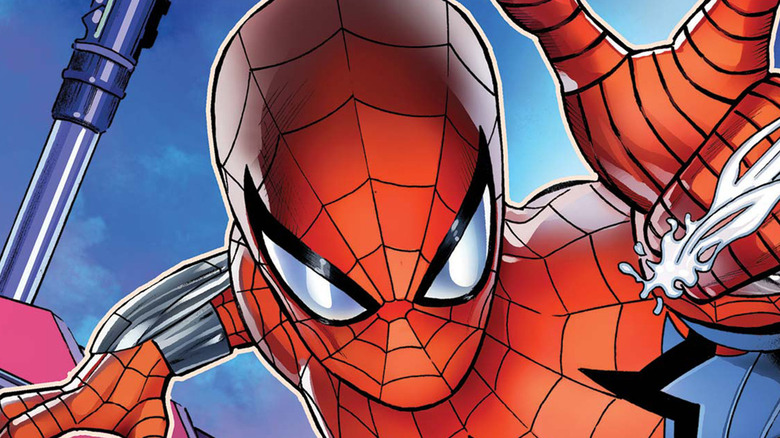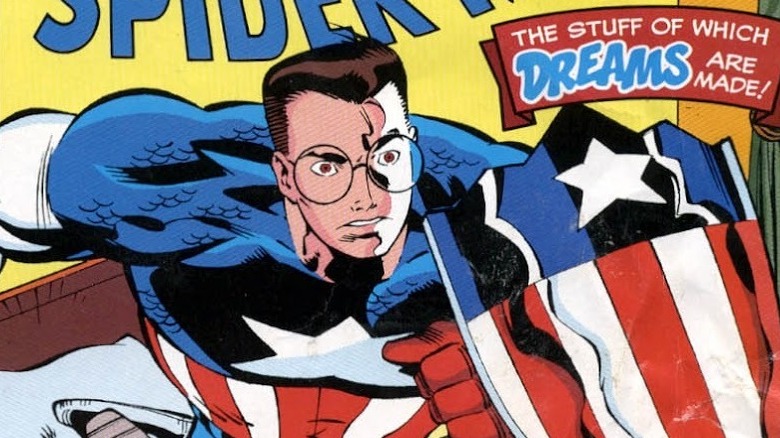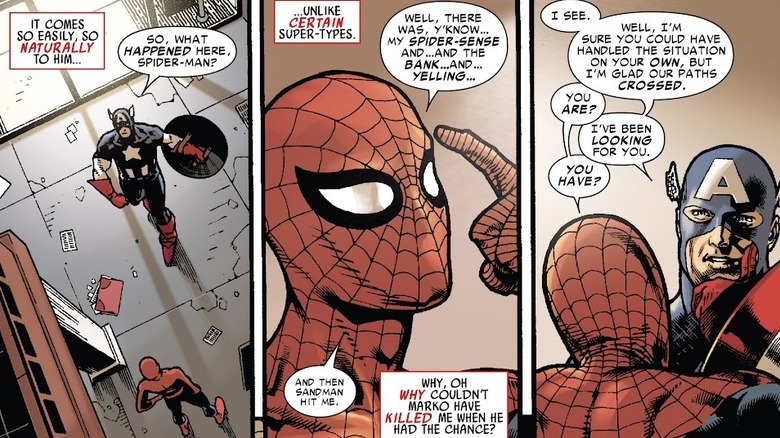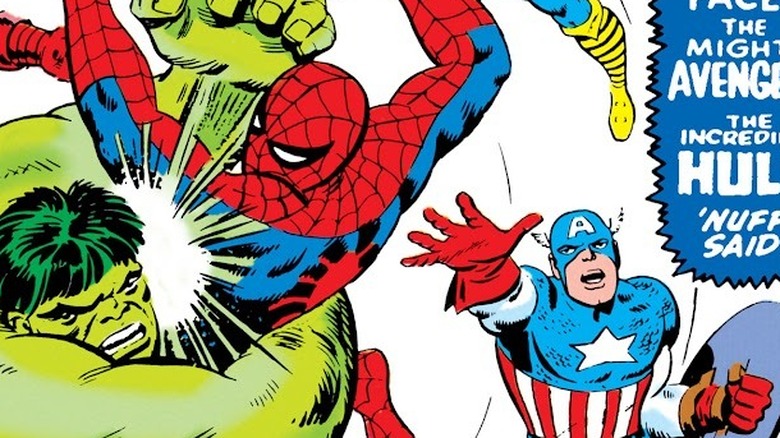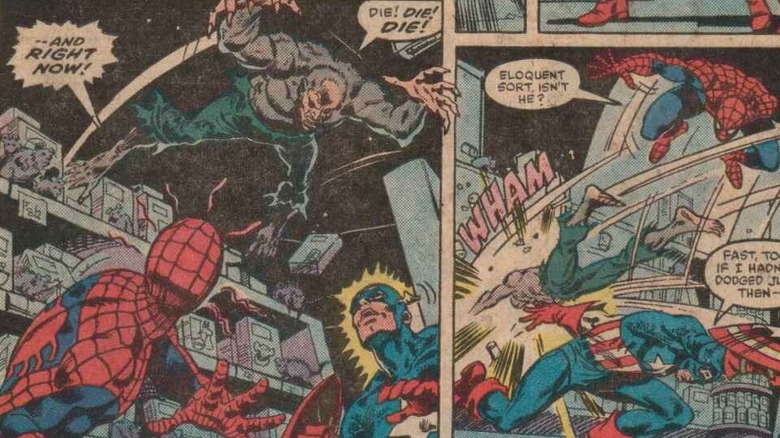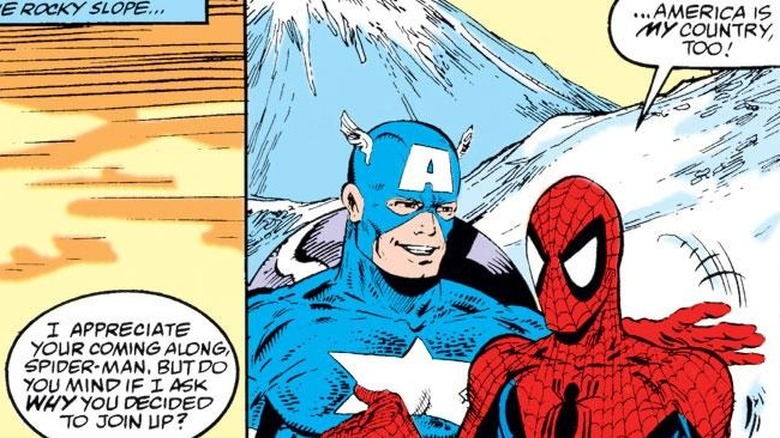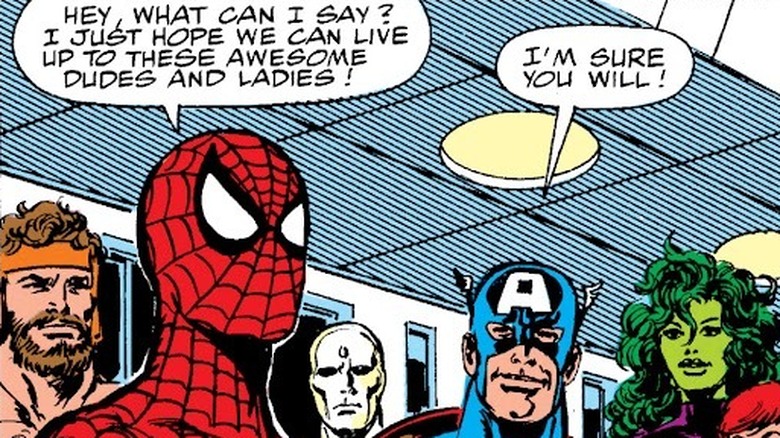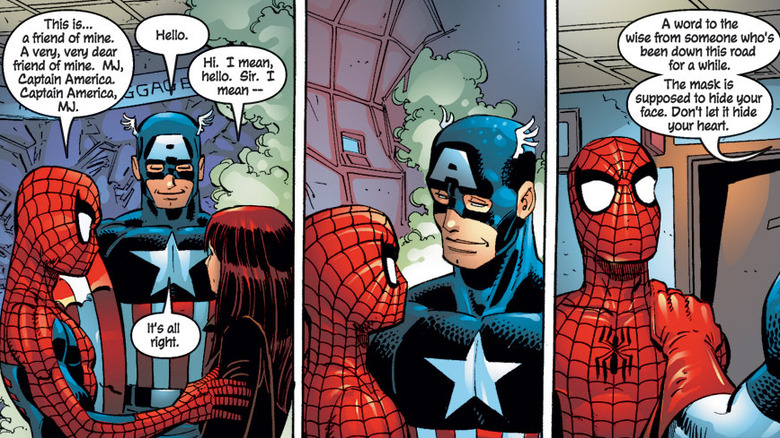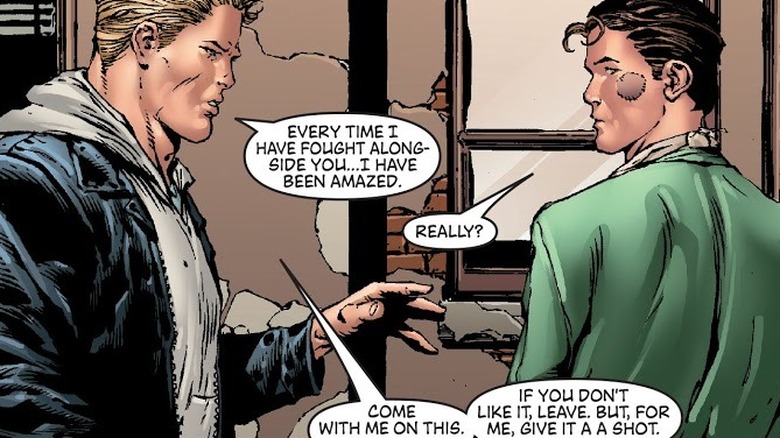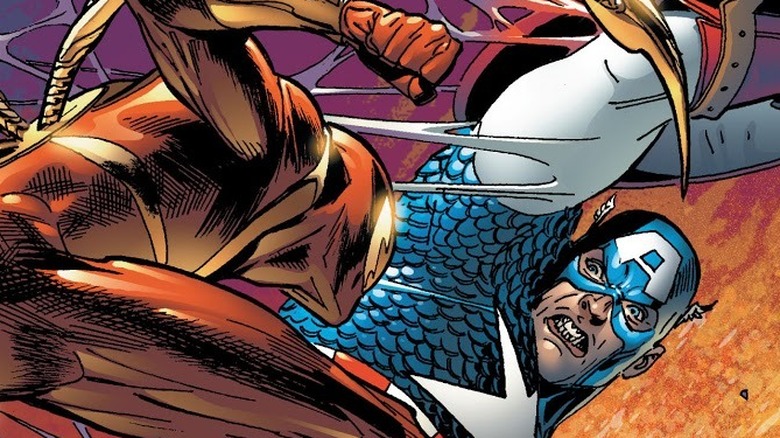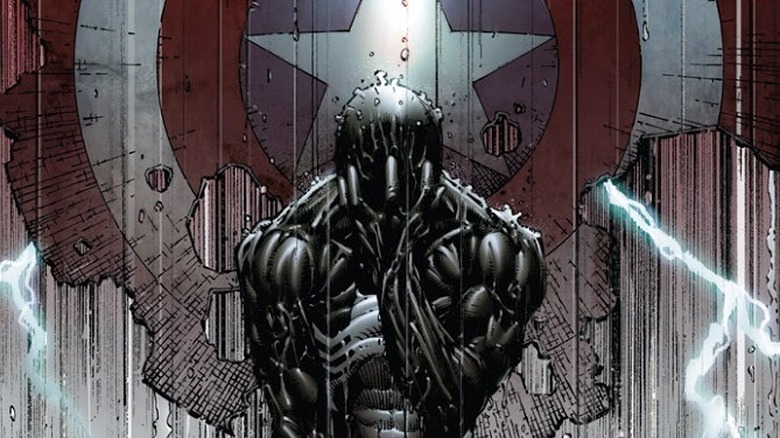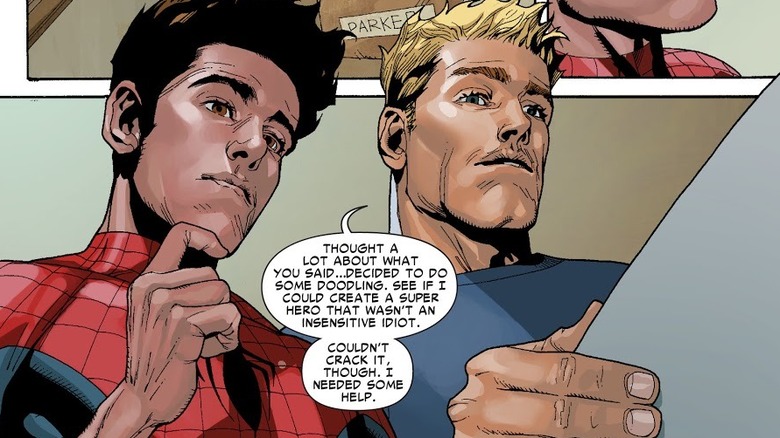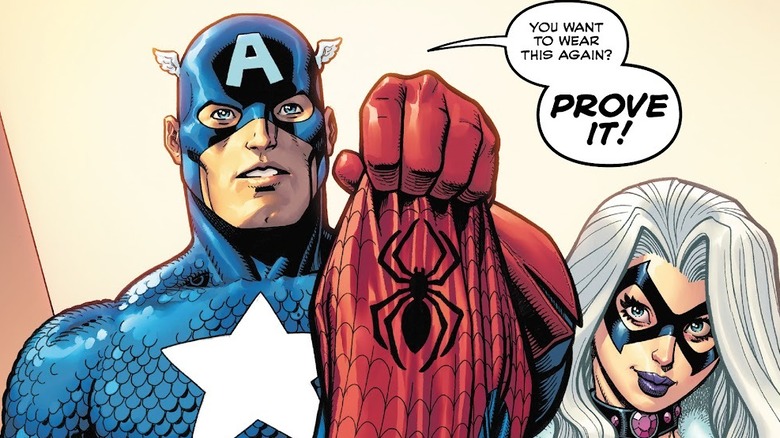The History Of Captain America's Relationship With Spider-Man Explained
Despite his iconic branding as the "friendly neighborhood" superhero of the Marvel universe, Spider-Man has had a pretty rough journey — especially in terms of relationships. It's not just his bond with the citizens of New York that suffers, but the rest of the superpowered do-gooder community as well. For many reasons, the people of Spider-Man's world have had a difficult time trusting him, with many initially believing the lies and accusations thrown at him by the Daily Bugle's J. Jonah Jameson.
That said, there are still a few people who are able to look past the bad publicity and decide for themselves that Spider-Man truly is a hero. Among the spandex-clad crowd, one of the most prominent figures who's been on Team Spidey since the web-slinger's very beginning is the Sentinel of Liberty himself, Captain America.
Fans who are most familiar with the Marvel Cinematic Universe's take on Spider-Man associate the young hero more closely with Iron Man. But within the comics, Steve Rogers has played a significant role in Peter Parker's life since before he even received his fateful spider bite. How did the Star-Spangled Avenger go from being a young boy's idol to a seasoned superhero's trusted friend and teammate? We're here to find out. This is the history of Captain America's relationship with Spider-Man, explained.
Young Peter Parker daydreamed about being Captain America
During the 1940s, a frail-bodied young artist named Steve Rogers made a fateful decision: In order to serve his country and fight the Nazis, he volunteered to be the test subject for an experimental serum. This selfless choice ended up transforming him into the mighty Captain America, changing his life forever. Decades later, another skinny youth would find himself inspired by the Captain's adventures and example, unaware that he was due for a life-changing transformation (albeit an accidental one) himself.
In the 1997 flashback issue "Amazing Spider-Man" #1, a young Peter Parker — who has yet to be bitten by a radioactive spider — stumbles upon his Uncle Ben's collection of old comic books while helping clean the attic. In an attempt to encourage Peter to take up sports and build self-esteem, Uncle Ben lets Peter keep his old comics in exchange for playing a few rounds of baseball. This predictably doesn't end well for the decidedly unathletic Peter, but he does find solace in the world of Uncle Ben's comics, even daydreaming about being the confident and courageous Captain America.
It is later revealed that this stroke of inspiration — combined with Peter's imagination, scientific brilliance, and desire to uphold justice — leads him to develop a prototype for the web-shooters he goes on to use as Spider-Man.
The wall-crawler meets the super-soldier
As a symbol of hope during wartime, Captain America has mostly enjoyed positive buzz from the media and the near-unanimous support of his countrymen. In contrast, Spider-Man's early days are filled to the brim with negative publicity that seems to hound him from every corner.
Taking place a few days after Spider-Man saves the Avengers from his robot doppelganger, "Amazing Spider-Man Annual" #37 captures the wall-crawler's first formal encounter with the Star-Spangled Avenger, immediately after the former subdues the Sandman. (In a neat twist, the Sandman ends up turning over a new leaf later on, even joining the Avengers himself, albeit briefly.) After a quick chat, in which Captain America thanks Spider-Man and offers his assistance in the future, four time-travelling scientists suddenly appear, apparently aiming to terminate the Sandman to avert an imminent global disaster. Working together, Spider-Man and Captain America manage to save the Sandman and change the course of history.
The next day, Captain America tracks down Spider-Man again and offers to make a public statement to clear his name. Spider-Man appreciates the gesture, but realizes that his bad reputation could drag the Captain down. Thus, he turns down the offer and swings away. It is implied that this encounter ends up inspiring Cap to allow reformed criminals to join the Avengers, planting the seeds of his formation of the "Kooky Quartet" with Scarlet Witch, Quicksilver, and Hawkeye.
A botched attempt at Avengers membership
For much of Spider-Man's publication history, his reputation as a loner has been the status quo. There are just so many things that make it difficult for him to stay on a team, from his adamant refusal to share his secret identity to his oftentimes off-putting sense of humor. That's not to say, however, that he hasn't tried to join some of Earth's premiere super-teams over the course of his career.
After Spider-Man fails to join the Fantastic Four in "Amazing Spider-Man" #1, he decides he's better off on his own. This is why he's surprised to receive an invitation from the mighty Thor to join the Avengers in "Amazing Spider-Man Annual" #3. Peter opts in, realizing that such a high-profile membership could certainly help both his finances and his PR. Unfortunately, Spider-Man's temper causes his formal application to devolve into a massive scuffle with the entire team. Captain America comes up with a swift solution: They'll test Spider-Man to see if he's truly Avengers material.
The team asks him to bring in the Hulk, who was recently seen in the city. Spider-Man finds and subdues the Hulk — but after seeing him revert to Bruce Banner, the hero has a change of heart, and decides the Hulk deserves to be free. Spider-Man returns to Avengers Mansion and reports his "failure," intentionally botching his membership bid.
Teaming up against an unbeatable foe
Spider-Man and Captain America have both amassed impressively villainous rogues galleries, which feature an assortment of bad guys they've been able to deal with on their lonesome. However, some foes are so deadly, they've required Spider-Man and Captain America to team up. One such instance ended up playing a key role in one of Spider-Man's most traumatic experiences.
"Marvel Team-Up" #128 sees Spider-Man and Captain America work together to take down Vermin, a mutated rat-human hybrid who commands an army of rodents and wants to take over the streets. Vermin proves to be a tad too strong and agile for either hero to beat on their own, and even manages to momentarily get the upper hand on both of them during a fight inside a cramped grocery store. With much effort, the duo eventually beats Vermin, after which they go their separate ways.
However, the fact that Spider-Man needed Captain America's help haunts him later on, when Kraven the Hunter schemes to bury Spider-Man alive and take his place, thus proving himself superior to his arachnid foe. Dressed in Spider-Man's black costume, he beats and captures Vermin, an enemy Spider-Man couldn't take down on his own, and sets him free. Spider-Man must chase him down after literally digging himself out of his own grave.
The Assassin Nation plot
Prior to Spider-Man's eventual acceptance into the Avengers, he and Captain America frequently cross paths. One of the most prominent examples of this happens during "Secret Wars," an event that sees numerous heroes and villains get whisked away and forced to fight on the makeshift planet Battleworld. It is during this adventure that Spider-Man comes to possess the alien symbiote costume that later becomes the anti-hero Venom.
On another occasion, the two superheroes team up to save the reputations of not one, but two countries: the United States and the fictional nation of Symkaria. In the "Assassin Nation Plot" storyline, a hired killer targets the king of Symkaria and ends up killing the country's prime minister instead. The perpetrators frame the United States for this, aiming to cause an international incident to destroy the country. Spider-Man gets involved in an attempt to assist his occasional ally, Symkarian mercenary squad leader Silver Sable. Soon enough, Captain America drops in (literally, via parachute) to help the ragtag bunch investigate the matter.
It is eventually revealed that the assassin was the mutant criminal Sabretooth, and that the true goal of the ultimate mastermind — none other than longtime Captain America foe Red Skull — is to destroy the United States' Constitution, Declaration of Independence, and Bill of Rights, pin it on Symkaria, and make war inevitable. Unsurprisingly, Spider-Man thwarts the Red Skull's plans and further earns Captain America's respect.
Spider-Man, Avengers reservist
Given that Captain America has become almost synonymous with the Avengers ever since the original team saved him from an icy demise in "The Avengers" #4, it's not surprising that many of Spider-Man's encounters with the Star-Spangled Avenger are connected to the team and his failed attempts to join it.
In "The Avengers" #236, Spider-Man breaks into Avengers Mansion to join the team (after Thor invited him to become part of it 15 issues earlier). Before the Avengers can properly deal with him, they are forced to leave via Quinjet to address an urgent threat. Spider-Man hitches a ride in a web cocoon under the jet, much to Captain America's consternation. The team is forced to work with him while fighting the Lava Men, but Spider-Man's over-eagerness and inability to follow orders becomes apparent (with Captain America even calling him a "young fool" at one point). In the end, despite Captain America's personal request, the U.S. government vetoes Spider-Man's potential membership due to him being a "major security risk."
Spider-Man wouldn't officially be counted among the Avengers' ranks until 1990's "The Avengers" #329. But he isn't actually made into a full-time member at this point — rather, he becomes one of seven reservists, alongside the Black Knight, Falcon, Hercules, Captain Marvel, and probationary Avengers Rage and Sandman. They take the place of anyone on the main roster who can't fulfill their duties.
A fateful airport encounter
Being married to a superhero can be extremely difficult — just ask Mary Jane Watson-Parker. Despite their intense love for each other, Peter and Mary Jane have had to weather some particularly tough times. For a while, the two even have to live separately, just so they can work out their issues and priorities. As luck would have it, no less than Captain America himself ends up playing a part in their eventual reconciliation.
"Amazing Spider-Man" #50 sees Peter and Mary Jane have a serious talk about their relationship in an airport, only to be interrupted by the arrival of Doctor Doom — and a subsequent assassination attempt on the Latverian ruler's life that causes entire sections of the airport to collapse. Peter springs into action as Spider-Man and rescues a disguised Captain America from the ruins. Together, they fight off numerous would-be assassins in robotic suits, saving Doom's life in the process.
After the chaos ends and emergency responders arrive, Peter (still suited up as Spider-Man) and Mary Jane are able to continue their conversation, with the latter jestingly bringing up that Peter never introduces her to his superhero colleagues. This prompts Peter to formally introduce Mary Jane to Captain America as "a very, very dear friend." The wise war veteran is quick to pick up on the truth, and leaves Spider-Man with an important piece of advice: "The mask is supposed to hide your face. Don't let it hide your heart."
Forming the New Avengers
Due to the actions of the Scarlet Witch in the "Avengers Disassembled" storyline, the Avengers are left utterly broken and disbanded. Captain America is particularly distraught, admitting in "Avengers: Finale" that he never thought he'd see the day when the Avengers would cease to be a team. Of course, in the world of comics, status quo shake-ups like this rarely stick, and soon enough, a brand-new team of Avengers forms in the wake of the original's breakup. Most notably, Spider-Man finally earns a spot on the team as a permanent member, though this is largely because he's in the right place at the right time.
In "New Avengers" #1 (which takes place six months after the events of "Disassembled"), the supervillain known as Electro orchestrates a breakout from the Raft, a maximum security prison for supervillains. Spider-Man is one of a handful of heroes to respond to the crisis, along with Luke Cage, Spider-Woman, Daredevil, Captain America, and Iron Man. The assembled heroes end up working together well enough to mostly contain the madness. Afterwards, Captain America and Iron Man discuss putting the band back together to track down the villains who successfully escaped. Steve Rogers personally visits Peter Parker in "New Avengers" #3 to recruit him — and, naturally, Peter accepts.
Iron Spider versus Captain America
Even though Captain America recruits Spider-Man into the New Avengers, the web-slinger ends up forging a stronger relationship with his fellow scientist Iron Man. Unsurprisingly, Peter sides with Tony when the enforcement of the Superhero Registration Act — a mandate that effectively outlaws superheroes with secret identities — drives a wedge between Iron Man and Captain America. While Peter eventually switches sides, one of his most important assignments as part of Team Tony results in him directly confronting his superhero idol.
In "Amazing Spider-Man" #534, Spider-Man and Captain America come to blows after the former asks the latter to surrender. Despite the many advantages built into his spanking-new Iron Spider suit, Spider-Man is unable to defeat Captain America in hand-to-hand combat. However, Spider-Man soon realizes that he's on the wrong side of the argument, and after publicly denouncing Iron Man, meets up with Captain America on a rooftop in "Amazing Spider-Man" #537.
After their discussion, Captain America formally welcomes Spider-Man to the resistance group and takes him to their base — but not before delivering a now-iconic line: "When the mob and the press and the whole world tell you to move, your job is to plant yourself like a tree beside the river of truth, and tell the whole world — 'No, you move.'"
Grieving the fallen Captain America
The superhero Civil War ends with Iron Man's side claiming victory, the non-registered Avengers (and a fugitive Spider-Man) on the run, and Captain America seemingly assassinated. While the Captain eventually makes his triumphant return to the land of the living some time later, his apparent death sends shockwaves across the superhero community, practically uniting the pro-registration and anti-registration heroes in their grief. Among the heroes who take the loss of the Captain the hardest is Spider-Man, who's already seen his fair share of death and tragedy.
In "Fallen Son: The Death of Captain America" #4, an emotionally unstable Spider-Man, clad in his black costume, attacks the Rhino at the cemetery where Peter's Uncle Ben is buried. This turns out to be a massive mistake: The Rhino is merely visiting the grave of his mother, and Spider-Man's attack causes him to destroy her headstone. Understandably enraged, the armored villain nearly beats Spider-Man to a pulp, until a last-minute burst of strength and willpower allows the hero to defeat his foe. Wolverine gives Spider-Man a (very bad) pep talk after this battle, and while Spider-Man generally responds to his Avengers teammate with misplaced anger, their conversation does help him get through his grief, if only slightly.
Two nerds at heart bond over art
After Cap returns to life, some of his old artwork — specifically, a comic strip called "Liberty Bonds" he drew when he was in art school, during a time he believed this was the only way he could contribute to the war effort — is rediscovered and put up for auction by an antique hunter (as seen in "Avenging Spider-Man" #5). This piques Peter's curiosity, making him realize that he and Steve were actually both "nerds" in their youth. He proceeds to pester Steve about his erstwhile art career during an Avengers mission, and even brings it up at their headquarters. Cap dismisses him, though, and even asks Peter if he still plays with his first chemistry set, just to get his point across.
But in the end, Peter's persistence rekindles Steve's love of art. The two Avengers end up bonding over their geeky interests by collaborating on, appropriately enough, a superhero comic book.
Captain America inspires Spider-Man to go beyond
In the "Beyond" storyline, Peter's clone Ben Reilly returns and attempts to reclaim the title of one true Spider-Man at the behest of the Beyond Corporation. Initially, Peter isn't exactly sure how to deal with this — but a confrontation with the U-Foes leaves him bedridden and on the brink of death. As Ben operates as Spider-Man with Peter's blessing, Peter undergoes a slow process of recovery. He has a vast support network of people rooting for him to get back on his feet — one of whom gets the idea to help Peter by enlisting the aid of the most inspiring superhero in the Marvel universe.
In "Amazing Spider-Man" #87, the Black Cat asks Captain America to join her in helping Peter relearn how to be Spider-Man. The Captain readily agrees to this, serving as Peter's coach, nutritionist, and sparring partner, rolled into one. With assistance from the Star-Spangled Avenger himself, Peter's journey towards becoming Spider-Man once again rehabilitates not just his body, but his fighting spirit as well.
